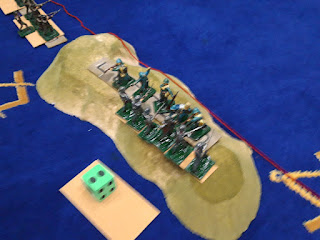We've actually been to Verdun with Tims 54mm stuff a couple of times before, but this game covered a later stage of the battle and took place during one of our f2f Friday games. I was joined by Graham and Pete on the German team, and in the week preceeding the game we had to plan our assault on a large map of the battlefield, request support assets and conduct some air recce missions.
I must confess I did most of the planning for the Germans , aided by my colleagues, I just have more time to do it now I'm retired. We were assigned a Corps of two divisions and I concentrated the bulk of our strength (six of eight regiments and three Stormtroop battalions) on a 3km frontage, aiming to take Fort Vaux, and then the ridges beyond. Overall depth of the assault was also 3km with three barrage lifts and a final protective artillery barrage line 4km deep, at the extreme range of our field artillery. Air recce focussed on each of the three main objective lines (yellow, red and green).
A somewhat dodgy photo of the 'plan' overlaid on the tourist map of Verdun. The blue lines are the division/brigade/regiment boundaries. The yellow, red, green and blue phase lines can be just made out, and the big opaque oval is two hours worth of heavy artillery fire on Fort Vaux and Batterie Damloup.
Battlefield from the north (behind the German lines).
For Vaux, with Batterie Damloup to to its right rear.
The German artillery park. Our bid for super heavy guns paid off handsomely! I particularly love the huge tinplate cannon on the left. Vintage 1920s/30s German.
Fort Vaux from the front. Rather imposing.
German HQ, field telephone team and the all important staff thunderbox.
Graham, Pete and I each took one Regimental sector, leading with the Stormtroop battalions. Pete and Graham had attached flamethrowers, but I had a figure I converted from a WW2 Airfix German 40 years ago - the guy with the big (plasticene) grenade bags, 3rd from the left. This is his combat debut.
It seems Fort Vaux has a rear door! That might prove useful....
The French were desperately short of supplies in the fort after weeks of intensive shelling, so time resupply by Monsieur hommes soupes.
There was an extensive French telephone network running from the fort just crying out to be cut.
One of Grahams stormtroop detachments makes it to the fort. How do we get inside?
My chaps approach the apparently unoccupied French trenches on the Red Line. Our barrage had utterly obliterated the Yellow Line and we took it without much opposition.
Although in theory our field guns could hit the Blue Line 3km further on from here, in practice we found the matchsticks barely carried over the Red Line, so it was danger close and the guns stopped as we approached. The Heavy Guns kept pounding the Blue Line however.
The wicked French responded with an artillery delivered gas strike! Lucky that a lot of my guys had gas masks moulded on. The gas and defensive rifle fire caused some losses.
The Stormtroops stormed through the gas, taking the Red Line.
Petes Stormtroops even overran Batterie Damloup, aided by their flamethrowers, although hilariously Petes first casualty was one of the flamethrower men. Just like every war film you've ever seen..
Having overrun the Red Line, Pete and I pressed on to the Green Line. Umm, there suddenly seem to be an awful lot of French soldiers there, and our field guns can't reach it. Oh dear...
Graham meanwhile had got hung up storming the Fort.
This was a slow and painstaking process as his troops first had to break into the tunnel complex, then fight their way down every corridor and turning. This took many, many turns to resolve, with the situation of the thirsty, starving defenders becoming every more desperate.
The Stormtroops failed to penetrate the Green Line, apart from one trench section in Petes sector. They fell back and were relived by the next wave of regular infantry, three entire Infantry Regiments, including the Leibgrenadier Regiment.
Rather than empty the box of figures, we modelled this as battalion columns with a single company at the front, and the others (notionally) deployed in depth behind and able to reinforce the front. Once a battalion had lost two thirds of its figures it was exhausted.
By now at Fort Vaux, the defenders had been pushed back into the depths. The German telephone team set up on the outside of the Fort to direct operations.
Back on the Red Line, the one critical point was this hill, which would allow us to overlook Verdun. Naturally it was the most heavily defended. The Leibgrenadier battalions just melted away (the big '2' on the dice shows there are just 2 figures left in the battalion reserve).
Eventually however, the entire Red Line fell into our hands. Both my Regiment and Grahams were exhausted, but Petes was still OK. He had been aided by the successful Stormtroop attack earlier in the day.
Back at Fort Vaux, the defenders finally capitulated and handed over the 'ornate bronze key to the fort' (as recounted by Alistair Horne). Well this was the best we could do.
In the real battle, Major Raynal, who commanded the garrison, was presented to the German Crown Prince Wilhelm, who in turn handed him a sword in recognition of the the heroic defence.
That was another great game, very atmospheric, and interspersed with quotes from 'The Price of Glory'. Many thanks to Tim for putting it on, and for my fellow players for making it so enjoyable.
























Being retired and still being able to get onto the floor to game is a contradiction in terms surely :-)
ReplyDeleteFascinating to see the full scope of a game played at that scale.
It was quite relaxing lying on the floor to fire matchsticks out of the Britain's 25pdrs!
Delete